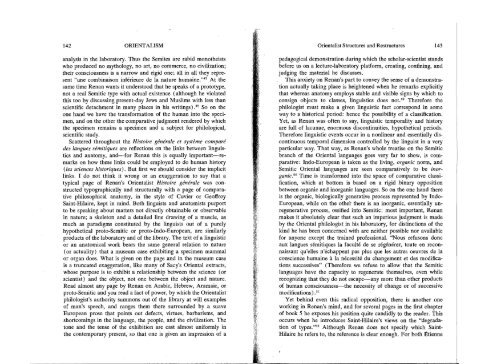Orientalism - autonomous learning
Orientalism - autonomous learning
Orientalism - autonomous learning
Create successful ePaper yourself
Turn your PDF publications into a flip-book with our unique Google optimized e-Paper software.
142 ORIENTALISM<br />
Orientalist Structures and Restructures<br />
143<br />
in the laboratory. Thus the Semites are rabid monotheists<br />
who produced no mythology, no art, no commerce, no civilization;<br />
their consciousness is a narrow and rigid one; all in all they represent<br />
"une combinaison inferieure de la nature humaine."*7 At the<br />
same time Renan wants it understood that he speaks of a prototype,<br />
not a real Semitic type with actual existence (although he violated<br />
this too by discussing present-day Jews and Muslims with less than<br />
scientific detachment in many places in his writings) .48 So on the<br />
one hand we have the transformation of the human into the specimen,<br />
and on the other the comparative judgment rendered by which<br />
the specimen remains a specimen and a subject for philological,<br />
scientific study.<br />
Scattered throughout the Histoire generale et systeme compare<br />
des langues semitiques are reflections on the links between linguistics<br />
and anatomy, and-for Renan this is equally important-remarks<br />
on how these links could be employed to do human history<br />
(les sciences historiques). But first we should consider the implicit<br />
links. I do not think it wrong or an exaggeration to say that a<br />
typical page of Renan's Orientalist Histoire generale was constructed<br />
typographically and structurally with a page of comparative<br />
philosophical anatomy, in the style of Cuvier or Geoffroy<br />
Saint-Hilaire, kept in mind. Both linguists and anatomists purport<br />
to be speaking about matters not directly obtainable or observable<br />
in nature; a skeleton and a detailed line drawing of a muscle, as<br />
much as paradigms constituted by the linguists out of a<br />
hypothetical proto-Semitic or proto-Indo-European, are<br />
products of the laboratory and of the library. The text of a linguistic<br />
or an anatomical work bears the same general relation to nature<br />
(or actuality) that a museum case exhibiting a specimen mammal<br />
or organ does. What is given on the page and in the museum case<br />
is a truncated exaggeration, like many of Sacy's Oriental extracts,<br />
whose purpose is to exhibit a relationship between the science (or<br />
scientist) and the object, not one between the object and nature.<br />
Read almost any page by Renan on Arabic, Hebrew, Aramaic, or<br />
proto-Semitic and you read a fact of power, by which the Orientalist<br />
philologist's authority summons out of the library at will examples<br />
of man's speech, and ranges them there surrounded by a suave<br />
European prose that points out defects, virtues, barbarisms, and<br />
shortcomings in the language, the people, and the civilization; The<br />
tone and the tense of the exhibition are cast almost uniformly in<br />
the contemporary present, so that one is given an impression of a<br />
pedagogical demonstration during which the scholar-scientist stands<br />
before us on a lecture-laboratory platform, creating, confining, and<br />
judging the material he discusses.<br />
This anxiety on Renan's part to convey the sense of a demonstration<br />
actually taking place is heightened when he remarks explicitly<br />
that whereas anatomy employs stable and visible signs by which to<br />
consign objects to classes, linguistics does not. 49 Therefore the<br />
philologist must make a given linguistic fact correspond in some<br />
way to a historical period: hence the possibility of a classification.<br />
Yet, as Renan was often to say, linguistic temporality and history<br />
are full of lacunae, enormous discontinuities, hypothetical periods.<br />
11herefore linguistic events occur in a nonlinear and essentially discontinuous<br />
temporal dimension controlled by the linguist in a very<br />
particular way. That way, as Renan's whole treatise on the Semitic<br />
branch of the Oriental languages goes very far to show, is comparative:<br />
Indo-European is taken as the living, organic norm, and<br />
Semitic Oriental languages are seen comparatively to be inorganic.<br />
50 Time is transformed into the space of comparative classification,<br />
which at bottom is based on a rigid binary opposition<br />
between organic and inorganic languages. So on the one hand there<br />
is the organic, biologically generative process represented by Indo<br />
European, while on the other there is an inorganic, essentially unregenerative<br />
process, ossified into Semitic: most important, Renan<br />
makes it absolutely clear that such an imperious judgment is made<br />
by the Oriental philologist in his laboratory, for distinctions of the<br />
kind he has been concerned with are neither possible nor available<br />
for anyone except the trained professional. "Nous refusons donc<br />
aux langues semitiques la faculte de se regenerer, toute en reconnaissant<br />
qu'elles n'echappent pas plus que les autres oeuvres de la<br />
conscience humaine a la necessite du changement et des modifications<br />
successives" (Therefore we. refuse to allow that the Semitic<br />
languages have the capacity to regenerate themselves, even while<br />
recognizing that they do not escape-any more than other products<br />
of human consciousness-the necessity of change or of successive<br />
modifications) .51<br />
Yet behind even this radical opposition, there is another one<br />
working in Renan's mind, and for several pages in the first chapter<br />
ofbook 5 he exposes his position quite candidly to the reader. This<br />
occurs when he introduces Saint-Hilaire's views on the "degradation<br />
of types."52 Although Renan does not specify which Saint<br />
Hilaire he refers to, the reference is clear enough. For both :£tienne
















